Abstract
Fusobacterium polymorphum has been isolated from the gingival crevice in humans and has been implicated in the immunopathology of periodontal diseases. The presence of alternative complement pathway factors in gingival crevice material suggests the contribution of this process in the manifestation of the local host response. A complement consumption assay was used to show that the anticomplementary activity of a cell-wall preparation from F. polymorphum in guinea pig complement progressed optimally at 37 degrees C and suboptimally at 0 degrees C. Similar levels of complement consumption were recorded at both temperatures, but a higher concentration of cell walls was required to demonstrate maximum activity in the cold. Augmentation experiments with additional normal and heat-treated complement showed the presence of heat-labile factors that controlled and limited the consumption of complement to a constant proportion of the total amount present. These same experiments indicated that there were no reactive antibodies in the complement used in the assay. Similar tests with C4-deficient guinea pig sera confirmed that F. polymorphum cell walls were capable of generating alternative complement pathway activity in guinea pig sera.
Full text
PDF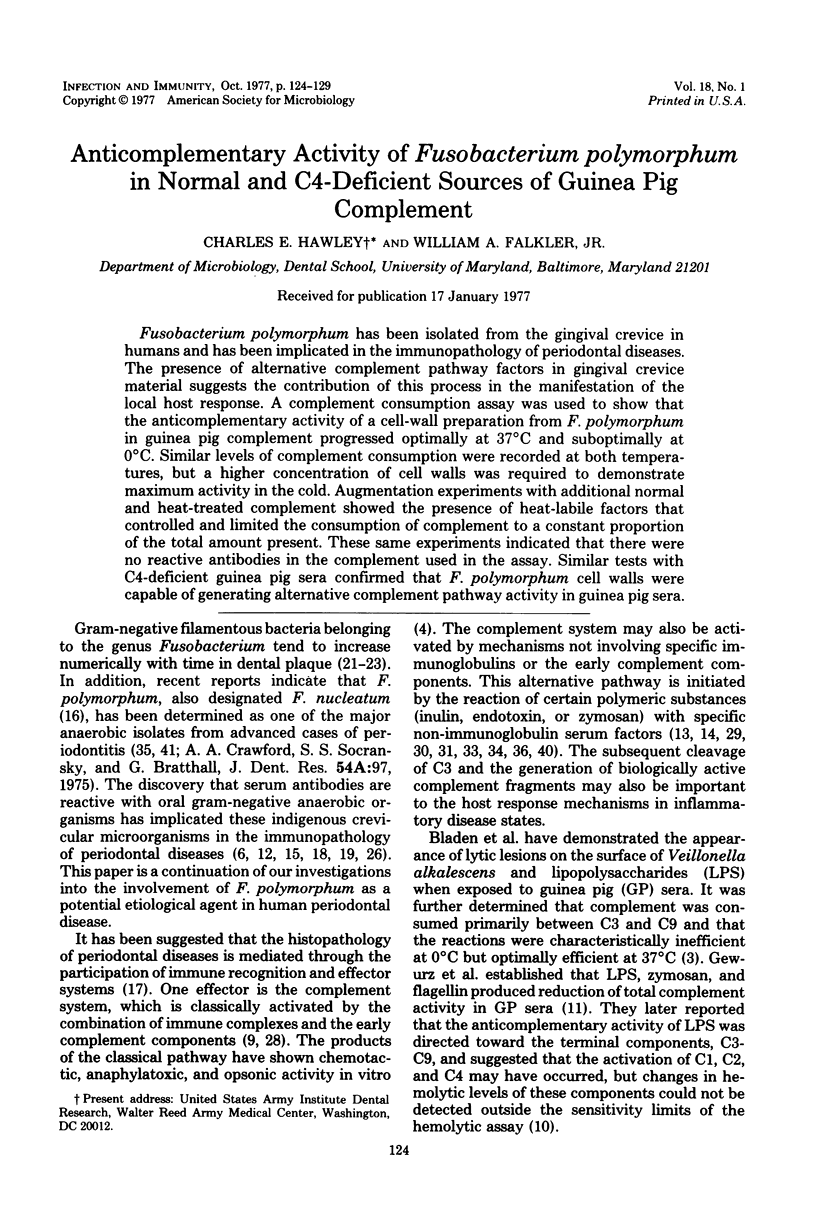
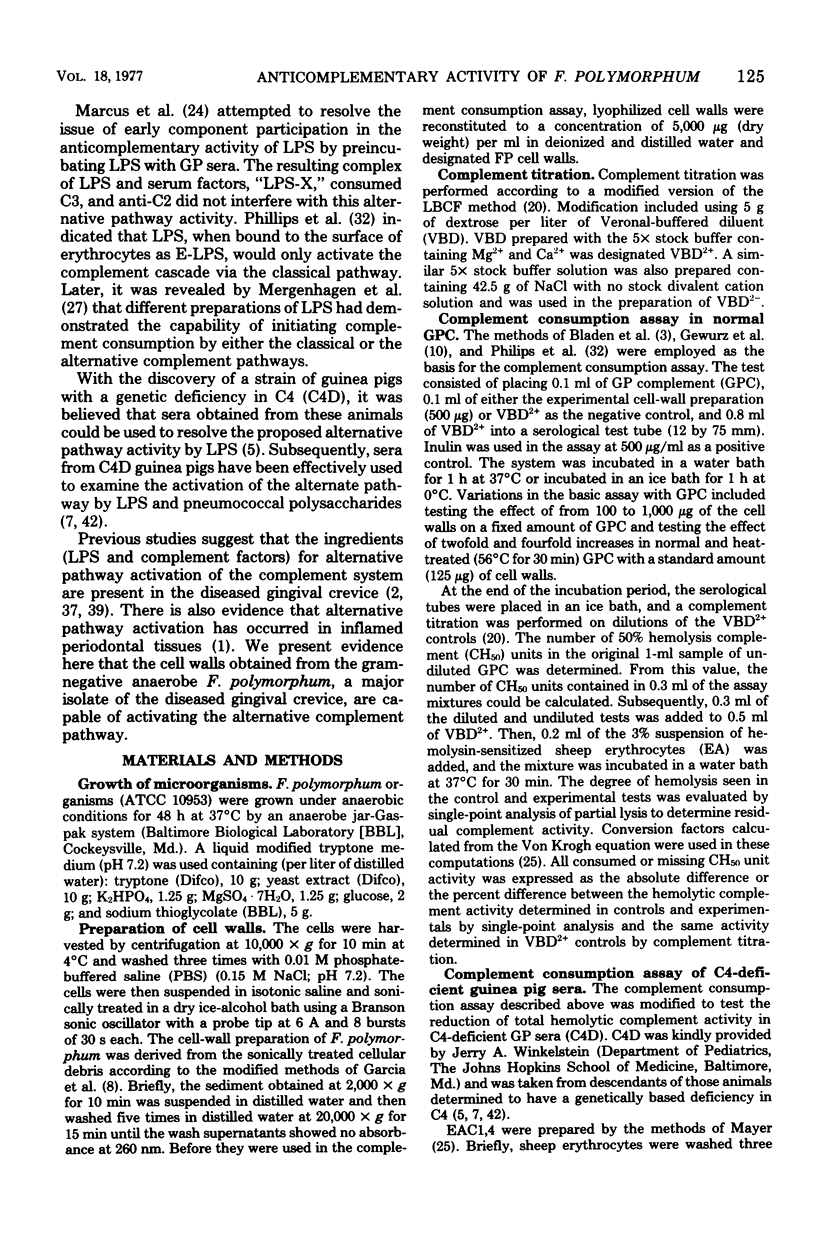
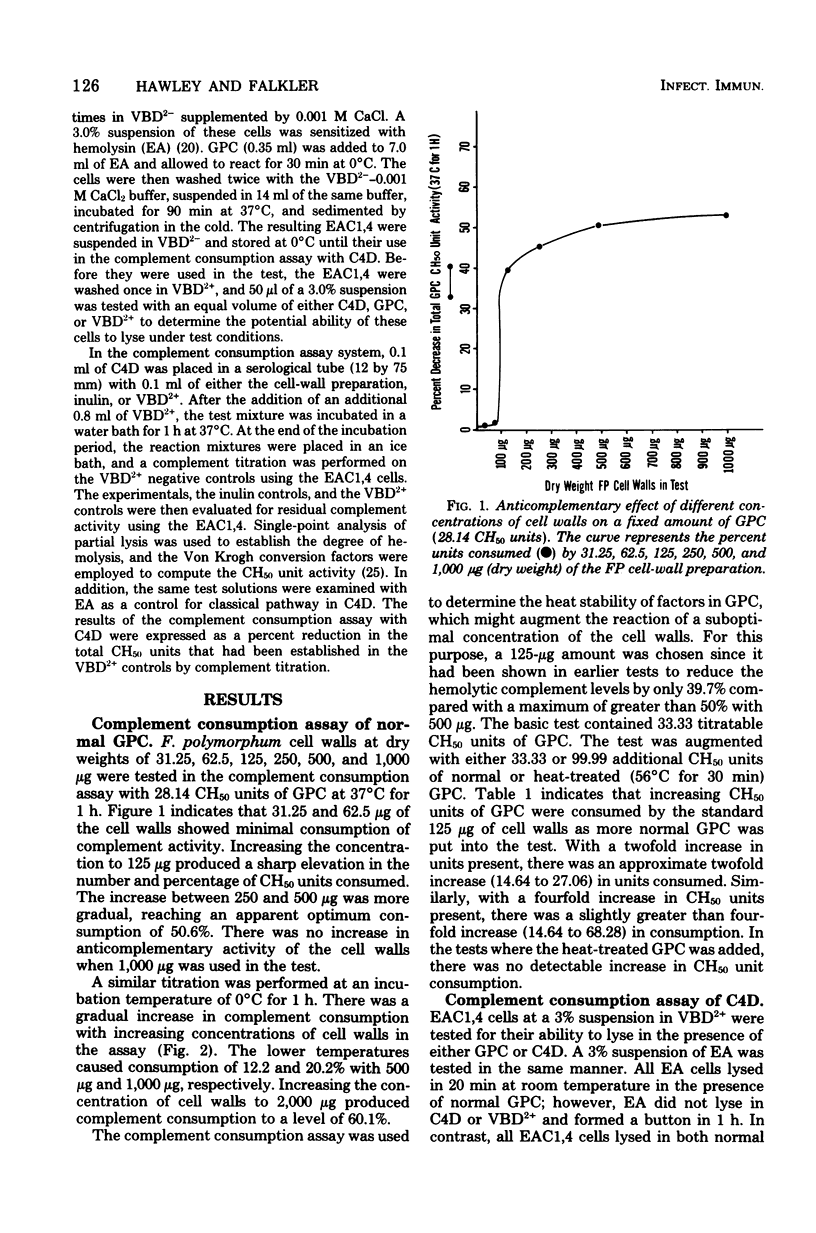
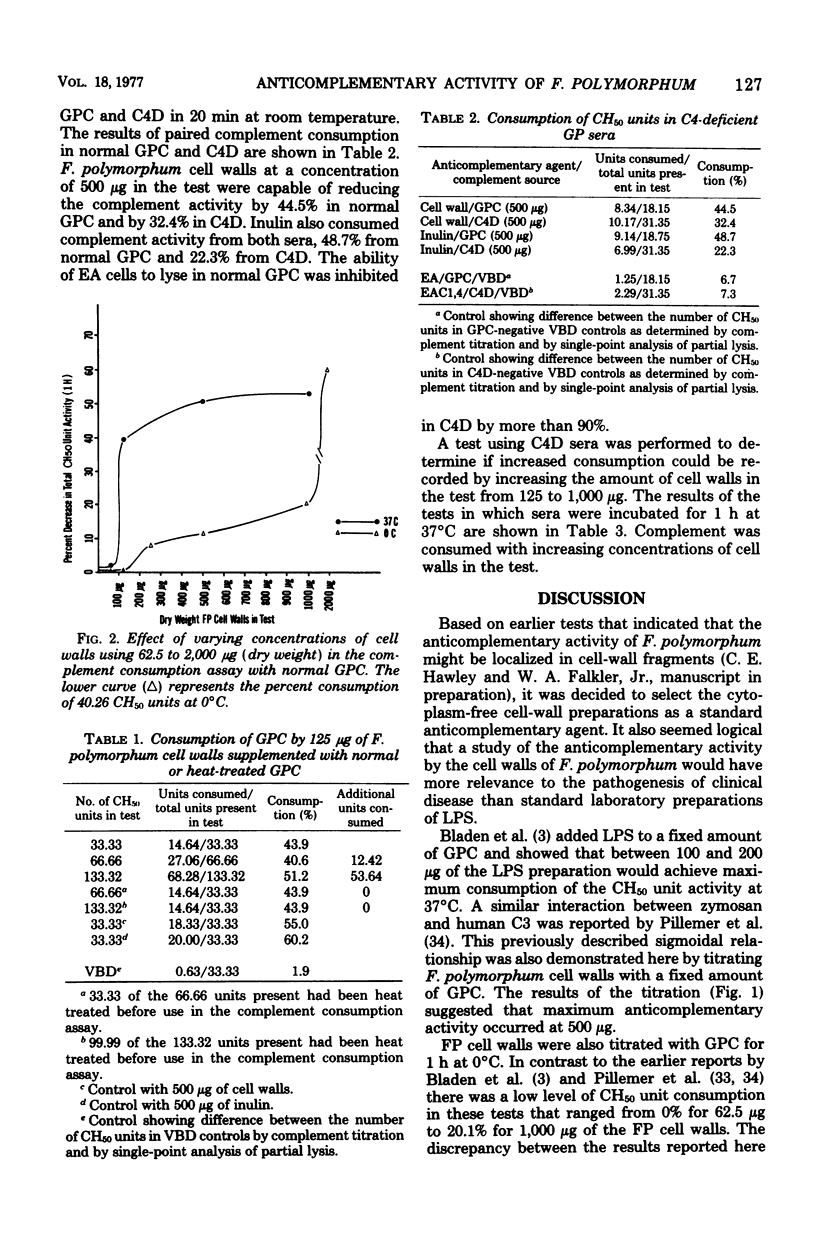

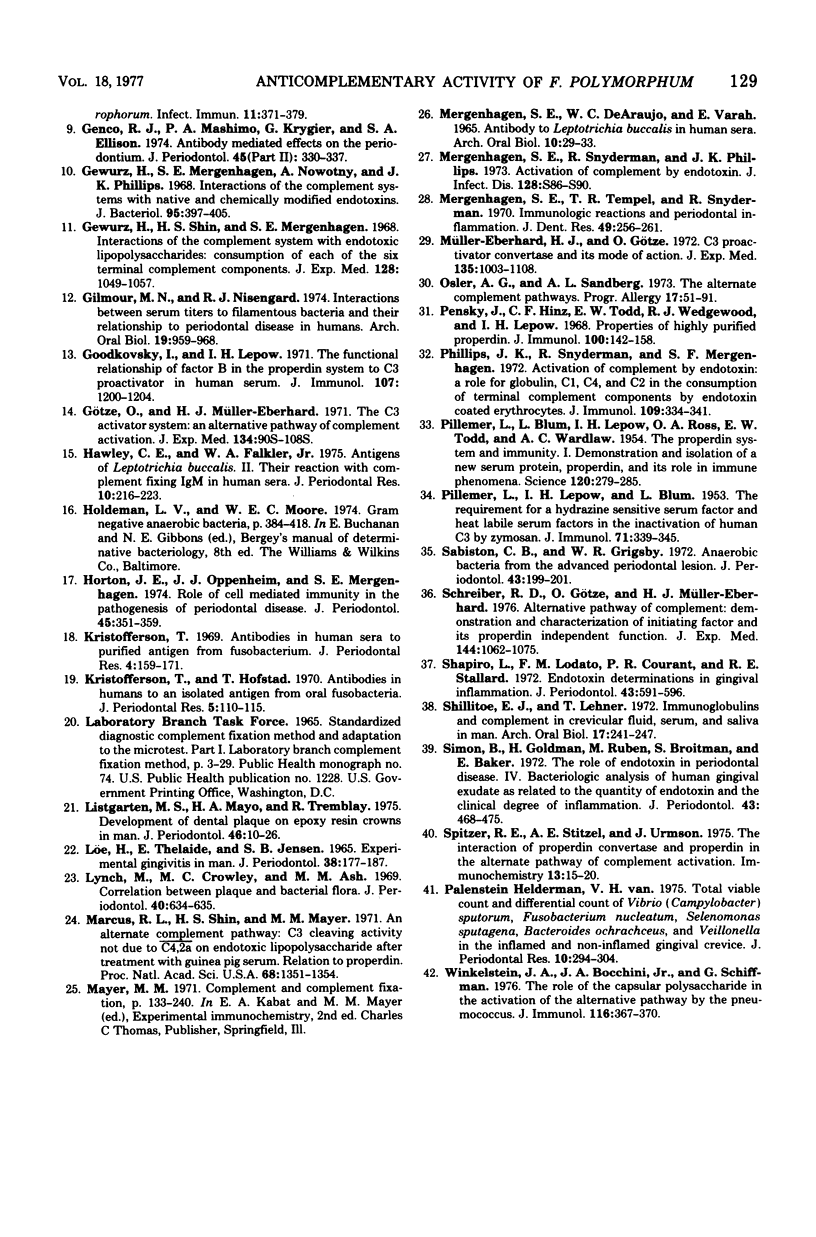
Selected References
These references are in PubMed. This may not be the complete list of references from this article.
- Attström R., Laurel A. B., Lahsson U., Sjöholm A. Complement factors in gingival crevice material from healthy and inflamed gingiva in humans. J Periodontal Res. 1975 Feb;10(1):19–27. doi: 10.1111/j.1600-0765.1975.tb00003.x. [DOI] [PubMed] [Google Scholar]
- Berglund S. E., Rizzo A. A., Mergenhagen S. E. The immune response in rabbits to bacterial somatic antigen administered via the oral mucosa. Arch Oral Biol. 1969 Jan;14(1):7–17. doi: 10.1016/0003-9969(69)90017-x. [DOI] [PubMed] [Google Scholar]
- Bladen H. A., Gewurz H., Mergenhagen S. E. Interactions of the complement system with the surface and endotoxic lipopolysaccharide of Veillonella alcalescens. J Exp Med. 1967 May 1;125(5):767–786. doi: 10.1084/jem.125.5.767. [DOI] [PMC free article] [PubMed] [Google Scholar]
- Ellman L., Green I., Frank M. Genetically controlled total deficiency of the fourth component of complement in the guinea pig. Science. 1970 Oct 2;170(3953):74–75. doi: 10.1126/science.170.3953.74. [DOI] [PubMed] [Google Scholar]
- Ensky J., Hinz C. F., Jr, Todd E. W., Wedgwood R. J., Boyer J. T., Lepow I. H. Properties of highly purified human properdin. J Immunol. 1968 Jan;100(1):142–158. [PubMed] [Google Scholar]
- Evans R. T., Spaeth S., Mergenhagen S. E. Bactericidal antibody in mammalian serum to obligatorily anaerobic Gram-negative bacteria. J Immunol. 1966 Jul;97(1):112–119. [PubMed] [Google Scholar]
- Frank M. M., May J., Gaither T., Ellman L. In vitro studies of complement function in sera of C4-deficient guinea pigs. J Exp Med. 1971 Jul 1;134(1):176–187. doi: 10.1084/jem.134.1.176. [DOI] [PMC free article] [PubMed] [Google Scholar]
- Garcia M. M., Charlton K. M., McKay K. A. Characterization of endotoxin from Fusobacterium necrophorun. Infect Immun. 1975 Feb;11(2):371–379. doi: 10.1128/iai.11.2.371-379.1975. [DOI] [PMC free article] [PubMed] [Google Scholar]
- Genco R. J., Mashimo P. A., Krygier G., Ellison S. A. Antibody-mediated effects on the periodontium. J Periodontol. 1974 May;45(5):330–337. doi: 10.1902/jop.1974.45.5.330. [DOI] [PubMed] [Google Scholar]
- Gewurz H., Mergenhagen S. E., Nowotny A., Phillips J. K. Interactions of the complement system with native and chemically modified endotoxins. J Bacteriol. 1968 Feb;95(2):397–405. doi: 10.1128/jb.95.2.397-405.1968. [DOI] [PMC free article] [PubMed] [Google Scholar]
- Gewurz H., Shin H. S., Mergenhagen S. E. Interactions of the complement system with endotoxic lipopolysaccharide: consumption of each of the six terminal complement components. J Exp Med. 1968 Nov 1;128(5):1049–1057. doi: 10.1084/jem.128.5.1049. [DOI] [PMC free article] [PubMed] [Google Scholar]
- Gilmour M. N., Nisengard R. J. Interactions between serum titres to filamentous bacteria and their relationship to human periodontal disease. Arch Oral Biol. 1974 Nov;19(11):959–968. doi: 10.1016/0003-9969(74)90081-8. [DOI] [PubMed] [Google Scholar]
- Goodkofsky I., Lepow I. H. Functional relationship of factor B in the properdin system to C3 proactivator of human serum. J Immunol. 1971 Oct;107(4):1200–1204. [PubMed] [Google Scholar]
- Götze O., Müller-Eberhard H. J. The C3-activator system: an alternate pathway of complement activation. J Exp Med. 1971 Sep 1;134(3 Pt 2):90s–108s. [PubMed] [Google Scholar]
- Hawley C. E., Falkler W. A., Jr Antigens of Leptotrichia buccalis II. Their reaction with complement fixing IgM in human sera. J Periodontal Res. 1975 Oct;10(4):216–223. doi: 10.1111/j.1600-0765.1975.tb00028.x. [DOI] [PubMed] [Google Scholar]
- Horton J. E., Oppenheim J. J., Mergenhagen S. E. A role for cell-mediated immunity in the pathogenesis of periodontal disease. J Periodontol. 1974 May;45(5):351–360. doi: 10.1902/jop.1974.45.5.351. [DOI] [PubMed] [Google Scholar]
- Kristoffersen T., Hofstad T. Antibodies in humans to an isolated antigen from oral fusobacteria. J Periodontal Res. 1970;5(2):110–115. doi: 10.1111/j.1600-0765.1970.tb00701.x. [DOI] [PubMed] [Google Scholar]
- LOE H., THEILADE E., JENSEN S. B. EXPERIMENTAL GINGIVITIS IN MAN. J Periodontol. 1965 May-Jun;36:177–187. doi: 10.1902/jop.1965.36.3.177. [DOI] [PubMed] [Google Scholar]
- Listgarten M. A., Mayo H. E., Tremblay R. Development of dental plaque on epoxy resin crowns in man. A light and electron microscopic study. J Periodontol. 1975 Jan;46(1):10–26. doi: 10.1902/jop.1975.46.1.10. [DOI] [PubMed] [Google Scholar]
- Lynch M., Crowley M. C., Ash M. M. Correlation between plaque and bacterial flora. J Periodontol. 1969 Nov;40(11):634–635. doi: 10.1902/jop.1969.40.11.634. [DOI] [PubMed] [Google Scholar]
- MERGENHAGEN S. E., DEARAUJO W. C. ANTIBODY TO LEPTOTRICHIA BUCCALIS IN HUMAN SERA. Arch Oral Biol. 1965 Jan-Feb;10:29–33. doi: 10.1016/0003-9969(65)90054-3. [DOI] [PubMed] [Google Scholar]
- Marcus R. L., Shin H. S., Mayer M. M. An alternate complement pathway: C-3 cleaving activity, not due to C4,2a, on endotoxic lipopolysaccharide after treatment with guinea pig serum; relation to properdin. Proc Natl Acad Sci U S A. 1971 Jun;68(6):1351–1354. doi: 10.1073/pnas.68.6.1351. [DOI] [PMC free article] [PubMed] [Google Scholar]
- Mergenhagen S. E., Tempel T. R., Snyderman R. Immunologic reactions and periodontal inflammation. J Dent Res. 1970 Mar-Apr;49(2):256–261. doi: 10.1177/00220345700490020901. [DOI] [PubMed] [Google Scholar]
- Müller-Eberhard H. J., Götze O. C3 proactivator convertase and its mode of action. J Exp Med. 1972 Apr 1;135(4):1003–1008. doi: 10.1084/jem.135.4.1003. [DOI] [PMC free article] [PubMed] [Google Scholar]
- Osler A. G., Sandberg A. L. Alternate complement pathways. Prog Allergy. 1973;17(0):51–92. [PubMed] [Google Scholar]
- PILLEMER L., BLUM L., LEPOW I. H., ROSS O. A., TODD E. W., WARDLAW A. C. The properdin system and immunity. I. Demonstration and isolation of a new serum protein, properdin, and its role in immune phenomena. Science. 1954 Aug 20;120(3112):279–285. doi: 10.1126/science.120.3112.279. [DOI] [PubMed] [Google Scholar]
- PILLEMER L., LEPOW I. H., BLUM L. The requirement for a hydrazine-sensitive serum factor and heat-labile serum factors in the inactivation of human C'3 by zymosan. J Immunol. 1953 Nov;71(5):339–345. [PubMed] [Google Scholar]
- Phillips J. K., Snyderman R., Mergenhagen S. E. Activation of complement by endotoxin: a role for 2 globulin, C1, C4 and C2 in the consumption of terminal complement components by endotoxin-coated erythrocytes. J Immunol. 1972 Aug;109(2):334–341. [PubMed] [Google Scholar]
- Sabiston C. B., Jr, Grigsby W. R. Anaerobic bacteria from the advanced periodontal lesion. J Periodontol. 1972 Apr;43(4):199–201. doi: 10.1902/jop.1972.43.4.199. [DOI] [PubMed] [Google Scholar]
- Schreiber R. D., Götze O., Müller-Eberhard H. J. Alternative pathway of complement: demonstration and characterization of initiating factor and its properdin-independent function. J Exp Med. 1976 Oct 1;144(4):1062–1075. doi: 10.1084/jem.144.4.1062. [DOI] [PMC free article] [PubMed] [Google Scholar]
- Shapiro L., Lodato F. M., Jr, Courant P. R., Stallard R. E. Endotoxin determinations in gingival inflammation. J Periodontol. 1972 Oct;43(10):591–596. doi: 10.1902/jop.1972.43.10.591. [DOI] [PubMed] [Google Scholar]
- Shillitoe E. J., Lehner T. Immunoglobulins and complement in crevicular fluid, serum and saliva in man. Arch Oral Biol. 1972 Feb;17(2):241–247. doi: 10.1016/0003-9969(72)90206-3. [DOI] [PubMed] [Google Scholar]
- Simon B. I., Goldman H. M., Ruben M. P., Broitman S., Baker E. The role of endotoxin in periodontal disease. IV. Bacteriologic analyses of human gingival exudate as related to the quantity of endotoxin and clinical degree of inflammation. J Periodontol. 1972 Aug;43(8):468–475. doi: 10.1902/jop.1972.43.8.468. [DOI] [PubMed] [Google Scholar]
- Spitzer R. E., Stitzel A. E., Urmson J. Interaction of properdin convertase and properdin in the alternative pathway of complement activation. Immunochemistry. 1976 Jan;13(1):15–20. doi: 10.1016/0019-2791(76)90291-3. [DOI] [PubMed] [Google Scholar]
- Winkelstein J. A., Bocchini J. A., Jr, Schiffman G. The role of the capsular polysaccharide in the activation of the alternative pathway by the pneumococcus. J Immunol. 1976 Feb;116(2):367–370. [PubMed] [Google Scholar]
- van Palenstein Helderman W. H. Total viable count and differential count of vibrio (campylobacter) sputorum, fusobacterium nucleatum, selenomonas sputigena, bacteroides ochraceus and veillonella in the inflamed and non inflamed human gingival crevice. J Periodontal Res. 1975 Nov;10(5):294–305. doi: 10.1111/j.1600-0765.1975.tb00037.x. [DOI] [PubMed] [Google Scholar]


